Why Do People Believe in Chemtrails? | Earth Focus | News & Community
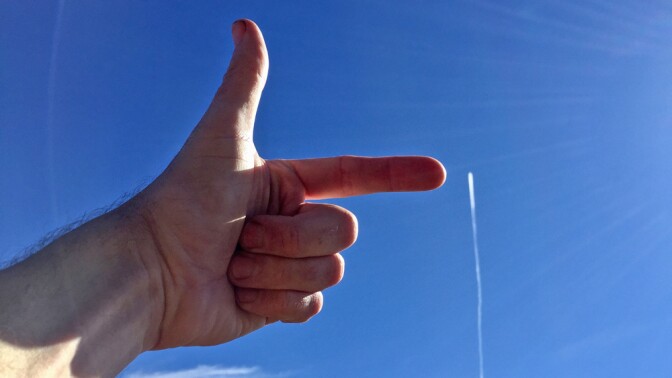

The story goes like this: contrails, those innocent-looking linear clouds of condensed water vapor left behind by passing jet planes aren’t innocent at all. They’re the visible evidence of a massive conspiracy, in which airlines and government agencies are working together to spray substances into the atmosphere. People who subscribe to this line of thinking call them “chemtrails.”
Why would shadowy conspirators do such a thing? That depends on who you ask.
Some hold that chemtrails are part of a massive mind control effort, pointing to rumors of lithium as one of the substances sprayed at 30,000 feet or so. Others say it’s an attempt to control global warming, and still others say chemtrails are there to make the global warming “hoax” more convincing. Still others think it’s all a secret weapons testing program, while some seem to accept a mixture of all these sometimes mutually contradictory motives.
There are plenty of reasons not to believe that chemtrails are real.
For instance, there’s the believers’ contention that persistent contrails didn’t exist until somewhere around the late 1990s, when the program is said (by many adherents) to have started. That’s easily countered by being older than 35, having looked at the sky before 1995, and remembering persistent contrails. (Personally, I distinctly recall my father explaining to me how contrails formed — water vapor from jet exhaust condensing into ice crystals as it hits the cold air — as we watched a couple of them in the Central New York sky in 1963 or so.)
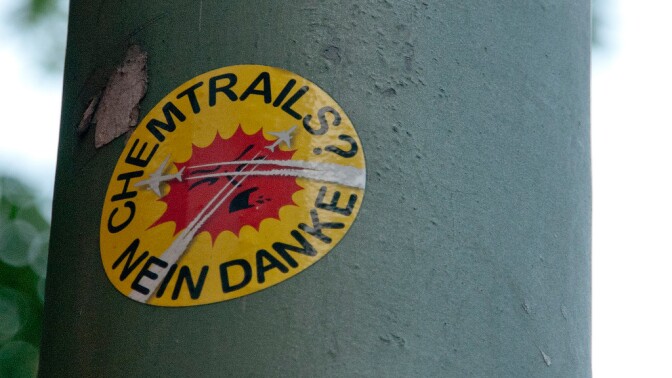

Then there’s the nearly complete dismissal of the chemtrails notion among atmospheric scientists, environmental groups working on air quality issues, and engineers familiar with aircraft mechanics. Proving that chemtrails are real would be a career-maker for a scientist. But in the 20 years since the rumor started gaining ground there has been just one peer-reviewed paper on the topic, and that paper — a survey of 77 atmospheric chemists — found that just one of them thought chemtrail spraying might explain some of the data the experts had reviewed, though she also granted that spraying wasn’t the only possible explanation.
Chemtrail advocates point out that persistent contrails are much more prevalent than they once were, which is true. That’s easily explained by dramatic increases in air traffic, as well as by changes in the fuel efficiency of jet engines leading to cooler exhaust, and increased water vapor in the atmosphere due to global warming.
There’s also the demonstrated inability of our federal government to keep even the smallest secrets out of the public eye for very long. Chemtrail spraying would necessarily involve binding thousands of people to secrecy, from aircraft mechanics to pilots to accountants at oil companies to temps in the mailroom of the Federal Aviation Administration. The thought of that many people agreeing to keep secret a program to harm millions of people strains credulity. At this point, Donald Trump can’t even hold a top-level meeting with the Russian ambassador in the Oval Office without us hearing about it the next day.
Chemtrails believers reading this article this far will almost certainly suspect me, and probably KCETLink, and possibly some shadowy figure funding KCETLink, of the same stubborn closed-mindedness that their detractors ascribe to them.
And there’s the long-honored logical principle of Occam’s Razor, which says more or less that when you’re choosing among several possible explanations for a phenomenon, the simplest one is usually the best place to start. And water vapor condensing in very cold high-altitude air is way simpler than a shifting plot among thousands of people to spray things on people for undetermined reasons.
And yet people still take the notion very seriously. In fact, chemtrails believers reading this article this far will almost certainly suspect me, and probably KCETLink, and possibly some shadowy figure funding KCETLink, of the same stubborn closed-mindedness that their detractors ascribe to them.
It’s the same kind of ideological divide that characterizes so much of our public discourse these days, in other words, on topics from Presidential politics to climate change to vaccinations. The chemtrails notion, in a way, is the distillation of the 21st Century public argument, with a seemingly unbridgeable gulf between the two sides.
And so examining the way people discuss — or more usually, argue over — the concept of chemtrails offers lessons for other controversies that may well be more important in political life.
One journalist who’s in the business of debunking false information holds the rancorous culture of social media to blame, at least in part, for the intractable aspect of the chemtrails controversy. Brooke Binkowski, managing editor of the veteran fact-checking site Snopes, cites the internet’s default recourse to insults as one reason that adherents to unsupported notions like the chemtrails conspiracy theory resist suggestions that they change their minds.
“To me this is a commentary on the toxic culture that has come to define much of the Internet,” Binkowski told me, “because it is nearly impossible to have a free exchange of views without it devolving into a crap fest.”
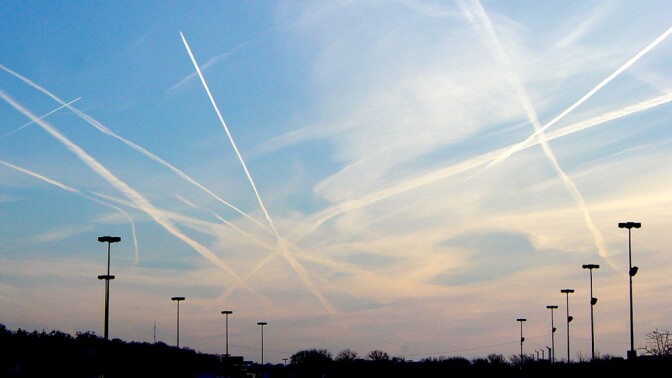

“Nobody responds well to being told they are stupid for believing the way they do,” Binkowski added. “I think that makes them dig in deeper.”
Making your opponent dig in deeper is generally the opposite of the result you want when you’re trying to persuade someone. But people on both sides persist.
My own work to put this piece together provides an example of the dynamic Binkowski mentioned. Several weeks back I posted a request on Facebook asking to talk to people who were persuaded of the reality of chemtrails. I said that I wanted to talk to them about how they came to that conclusion, whether they felt they were open to conflicting information, and why. I was upfront about the fact that I don’t find chemtrails plausible and said that the article would reflect that, but I promised that anyone talking to me would be treated with respect, as would their points of view.
Within minutes, skeptics had commented on the post with slams at believers’ intelligence, persisting even after pointed requests to stop. The climate thus tainted, supporters of the chemtrails idea posted links to YouTube videos and offered their own absolutist comments rather than engaging in conversation, either in the thread or privately. I finally deleted the post, but not before more than one skeptic had insulted me publicly for even saying I wanted to talk to chemtrails believers.
Binkowski is right: calling a person stupid due to their convictions is a way of deepening divides, not persuading debate opponents.
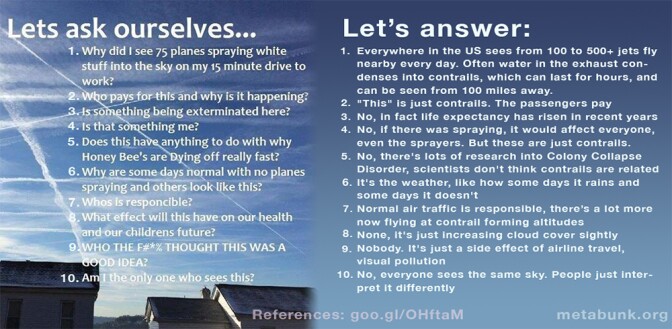

It’s also both incorrect and beside the point. Chemtrails believers include not only people with impressive educations, but people with impressive educations in the sciences. A scientific education trains you to challenge your preconceived notions in the light of new evidence, to reject hypotheses that don’t pass Occam’s smell test, and to grant the possibility that your entire world view might need to be discarded because one pesky fact doesn’t fit into it. But scientists are also human, and the most rigorous thinker in one scientific field might succumb to very human stubbornness and sloppy thinking in another.
Then there are the majority of us who aren’t scientists, doing our best to interpret the world around us given the barrage of information that confronts us daily. Even in the best of worlds the scientific process is confusing, with peer-reviewed studies contradicting previous peer-reviewed studies as the state of our understanding of the world progresses.


Sadly, we don’t live in the best of worlds. We live in a world in which people like Andrew Wakefield can abuse his authority to publish fraudulent studies which persuade thousands that a link exists between vaccinations and autism. No such link exists, but all the retractions and apologies in the world won’t persuade those who now see Wakefield as a victim rather than a charlatan.
We also live in a world in which people will publish news made up out of whole cloth just for the fun of deluding people, which accounts for the widespread impression among chemtrails believers that Donald Trump pledged to end their use while campaigning.
And though it is frustrating to see chemtrails advocates dismiss authoritative debunkings from scientists, an honest observer must admit that scientists themselves have handed conspiracists a few rhetorical brickbats to toss at them. Consider the infamous Tuskegee Experiment, for instance, in which African-American men were denied treatment for syphilis for 40 years so that researchers from the U.S. Public Health Service could study the unchecked progression of the disease while giving subjects the false impression their illness was being treated. A woke African American person who remembers Tuskegee and is on the fence about chemtrails might very reasonably raise an eyebrow at a suggestion to “just trust the scientists.”
more skepticism
Tuskegee is all the way over toward the evil end of the spectrum, but less dramatic examples of science reflecting the will of the powers that be rather than empirical reality are not exactly thin on the ground. There’s the time the United States’ leading wildlife science agency, the U.S. Fish and Wildlife Service, declared that “take permits” granted to wind turbine operators that allowed them to harm eagles couldn’t last for more than five years based on the best available eagle science. After four years of pressure from wind companies, the USFWS about-faced and said the best available science now allowed 30-year eagle take permits. (Eagle biology had not changed appreciably in the interim.) There’s the battle of the groundwater scientists disagreeing over the Cadiz water project, with those supported by the company coming up with figures that better support the company’s goals. There’s the above-mentioned example of Andrew Wakefield.
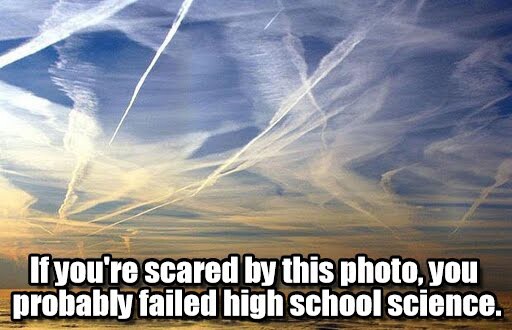

None of this is intended as a slam at individual scientists, who almost to a person are ethical, trustworthy, and forthright about their own conflicts and blind spots. As prominent as such lapses in scientific objectivity or integrity might be, they tend to be rare. Not nearly as rare as they ought to be, but rare.
But the lapses are often prominent, and that contributes to another common mechanism helping people take the chemtrails idea far more seriously than it warrants: confirmation bias. When you buy a car, and then suddenly notice that the streets are full of the same make and model of the car you just bought, that’s confirmation bias in its simplest form: we tend to note things that are familiar.
In the more specific world of logic, confirmation bias is the tendency for people to interpret information in ways that support their existing preconceptions. If a piece of information conflicts with your world view, you’re more likely to dismiss it, or simply fail to notice it, like a car of a different model than the one you just bought.
For a person who is persuaded that a shadowy conspiracy of scientists is working to keep the truth about chemtrails from a vulnerable public, the well-documented ethical lapses of scientists become very conspicuous. The hundreds of thousands of scientists in world history who have labored to improve life and aid or understanding of the world become that different-model car: unnoticed background information.
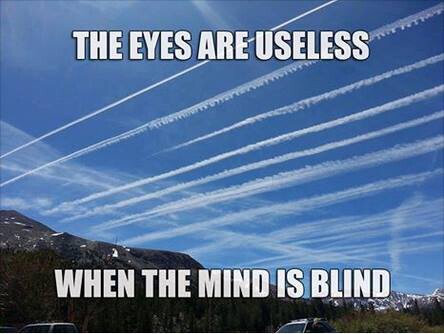

Chemtrail skeptics may decry the confirmation bias that affects their opponents’ world views, but they might as well decry breathing. Confirmation bias is wired into our brains, and minimizing its effect on how we perceive the world takes constant effort. No one escapes it.
Which means that the more effective way of addressing the issue of belief in the spurious idea of chemtrails — or vaccine denialism, or the citizenship of certain former Presidents, or any number of seemingly intractable rhetorical divides — may well be finding ways to increase the quality of the information we confirmation-bias-riddled people select from. For instance, social media companies could become more aggressive in filtering out hoaxes and deliberate lies such as the alleged Trump pledge to end chemtrails. Once the dross is somewhat filtered out, helping people improve their skill at assessing their information may make more of a difference.
“I think we need two things to end the free reign of the conspiracy theories that we are seeing everywhere now,” says Snopes’ Brooke Binkowski. “We need a robust and unfettered press that operates in a transparent and informative manner that values nuance and context. And moderation of social media, whether self-imposed or imposed from outside, will do wonders to help create and maintain a more constructive atmosphere of discussion so that people can more effectively communicate with one another.”
Which might make constructive, open-minded discussions a little bit less ephemeral than the clouds of ice crystals left behind by jet engines as they cross the sky.
Banner: contrails, entitled “Chemtrails” by photographer. Photo: baghee, some rights reserved


